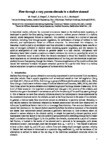Flow through a very porous obstacle in a shallow channel
| dc.contributor.author | Creed, Maggie | |
| dc.contributor.author | Draper, S | |
| dc.contributor.author | Nishino, T | |
| dc.contributor.author | Borthwick, Alistair | |
| dc.date.accessioned | 2021-08-22T17:08:03Z | |
| dc.date.available | 2021-08-22T17:08:03Z | |
| dc.date.issued | 2017-04 | |
| dc.identifier.issn | 1364-5021 | |
| dc.identifier.issn | 1471-2946 | |
| dc.identifier.uri | http://hdl.handle.net/10026.1/17713 | |
| dc.description.abstract |
<jats:p>A theoretical model, informed by numerical simulations based on the shallow water equations, is developed to predict the flow passing through and around a uniform porous obstacle in a shallow channel, where background friction is important. This problem is relevant to a number of practical situations, including flow through aquatic vegetation, the performance of arrays of turbines in tidal channels and hydrodynamic forces on offshore structures. To demonstrate this relevance, the theoretical model is used to (i) reinterpret core flow velocities in existing laboratory-based data for an array of emergent cylinders in shallow water emulating aquatic vegetation and (ii) reassess the optimum arrangement of tidal turbines to generate power in a tidal channel. Comparison with laboratory-based data indicates a maximum obstacle resistance (or minimum porosity) for which the present theoretical model is valid. When the obstacle resistance is above this threshold the shallow water equations do not provide an adequate representation of the flow, and the theoretical model over-predicts the core flow passing through the obstacle. The second application of the model confirms that natural bed resistance increases the power extraction potential for a partial tidal fence in a shallow channel and alters the optimum arrangement of turbines within the fence.</jats:p> | |
| dc.format.extent | 20160672-20160672 | |
| dc.format.medium | Print-Electronic | |
| dc.language | en | |
| dc.language.iso | eng | |
| dc.publisher | The Royal Society | |
| dc.subject | aquatic vegetation | |
| dc.subject | bed friction | |
| dc.subject | porous obstacle | |
| dc.subject | shallow channel | |
| dc.subject | tidal turbines | |
| dc.title | Flow through a very porous obstacle in a shallow channel | |
| dc.type | journal-article | |
| dc.type | Journal Article | |
| plymouth.author-url | https://www.ncbi.nlm.nih.gov/pubmed/28484321 | |
| plymouth.issue | 2200 | |
| plymouth.volume | 473 | |
| plymouth.publication-status | Published | |
| plymouth.journal | Proceedings of the Royal Society A: Mathematical, Physical and Engineering Sciences | |
| dc.identifier.doi | 10.1098/rspa.2016.0672 | |
| plymouth.organisational-group | /Plymouth | |
| plymouth.organisational-group | /Plymouth/Faculty of Science and Engineering | |
| plymouth.organisational-group | /Plymouth/Faculty of Science and Engineering/School of Engineering, Computing and Mathematics | |
| plymouth.organisational-group | /Plymouth/Users by role | |
| plymouth.organisational-group | /Plymouth/Users by role/Academics | |
| dc.publisher.place | England | |
| dcterms.dateAccepted | 2017-03-23 | |
| dc.identifier.eissn | 1471-2946 | |
| dc.rights.embargoperiod | Not known | |
| rioxxterms.versionofrecord | 10.1098/rspa.2016.0672 | |
| rioxxterms.licenseref.uri | http://www.rioxx.net/licenses/all-rights-reserved | |
| rioxxterms.licenseref.startdate | 2017-04 | |
| rioxxterms.type | Journal Article/Review |


